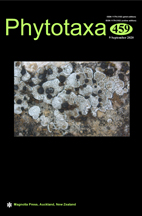Abstract
Asexual morph members of Tetraplosphaeriaceae (Pleosporales, Dothideomycetes) are generally hyphomycetes and usually found as saprobes occurring on various hosts in lentic habitats. Two isolates of a novel species, Tetraploa aquatica sp. nov., was collected from submerged decaying wood in Dulong river and a stream of Gaoligongshan mountain in Yunnan Province, China. The new species is characterized by short-cylindrical conidia, composed of 4-euseptate, short-cylindrical vertical columns which are verrucose at the base and with 4-setose vertical septate appendages. Tetraploa aquatica can be easily distinguished from other Tetraploa species by their columns which are 2–3-septate, aguttulate, vertical, setose
appendaged which tend to remain parallel to one another apically. Phylogenetic analyses of combined LSU, ITS and SSU sequence data support its natural placement in Tetraploa. Detailed description and illustrations of this species and comparisons with other morphologically similar taxa in Tetraploa are provided.

